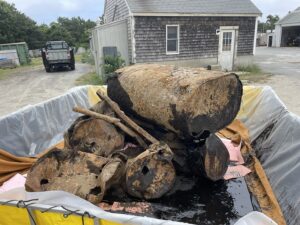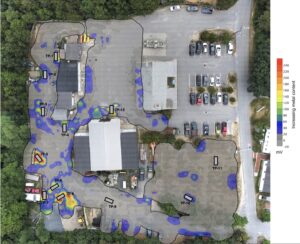TRURO — Twelve test pits dug at Truro’s current DPW site last week unearthed piles of metallic debris that had spent at least two decades underground, Director Jarrod Cabral said. One pit had so much spilled oil that the state Dept. of Environmental Protection (DEP) had to be called in.

The work was part of an environmental assessment of the site that is expected to take four to six months. The site is being considered for a new DPW facility.
A ground radar test on July 9 detected 12 spots where metal was likely located underground. On the day digging began, July 11, staff first came upon about 4,000 pounds of steel, including old snowplow blades, buried just outside the existing facility’s salt shed.
“It was a little odd,” Cabral said.
Later that day, contractors from HRP Associates hauled a 275-gallon oil tank and six oil drums and steel piping from a hole roughly eight feet deep at the rear of the property. The tank leaked fluid as it was removed. DPW staff called the DEP for permission to undertake an “immediate response action” and remove the leaking tank.
As the metals and oily soil were removed, the team took “about three dozen” samples for analysis. “The soil samples will tell us definitely what was in those drums,” Cabral said.
They will also indicate whether the team successfully removed all of the contamination. Staff removed about 30 gallons of what they believe was a combination of oil, waste oil, and petroleum from test pit 5. By the end, the pit was 30 by 20 feet wide and 10 feet deep. Along with the leaking oil, they removed about 45 cubic yards of contaminated soil.
The fire dept. assisted in containing the potentially hazardous materials. The oil-covered metals were placed on a rubber and polyethylene liner covered in absorbent pads.
Asked why the materials were buried there, Cabral said he had “no idea.” There’s a similar functioning oil tank on the property, he said, adding that the DPW is not in the practice of burying rubble.
Over two days of digging, the team unearthed heaps of concrete refuse, empty and crushed barrels, the chassis of a car or truck, a DPW truck hood, several tires, steel guardrail segments, and wooden telephone pole segments.
“I do a lot of these types of projects, and this is a very limited amount of material,” said Bryan Massa, a licensed site planner from HRP Associates, after the snowplow blades and oil were discovered but before the excavations were completed. “We need to collect more data to find out its full nature and extent, but this is a relatively small release.”
Siting Discussion
The environmental investigation is being funded through a measure approved by voters at town meeting on May 5 and a special town election on June 27.

The article authorized the select board to borrow $2.8 million to be used for engineering costs associated with a new facility “predominantly at the Town Hall Hill site (excluding the 340 Route 6 site).”
Discord persists over where the new facility can be located. Town Counsel John Giorgio of KP Law attended the July 9 meeting of the select board to address the legality of different location options.
Citizens and elected officials have disagreed about whether the May 5 vote precludes use of 340 Route 6 as a development site. Giorgio said last week that none of the approved funds can be used for sitework there.
“The role of town meeting was limited to appropriating the money and authorizing the borrowing,” Giorgio said. “However, town meeting cannot force the select board to act in a specific way.” While voters approved the borrowing, the select board carries out that borrowing.
Giorgio said that the Route 6 site is not entirely off the table, legally speaking, because the borrowing authorization could be amended at a future town meeting.
With lab analysis of soil samples expected to take 35 to 45 days, the DPW is proceeding with other aspects of environmental review.
Soil borings will test the ground at depths lower than test pits can go — about 20 feet below ground, said Massa. The boring is set to begin on July 18, and the plan is to drill in six to eight spots. Cabral said Monday that they might add one to two borings near test pit 5, where the oil was discovered, “to confirm that no further removal of soil is required.”
Later this month, the team will test monitoring wells at depths of 120 to 130 feet to assess groundwater flow. The total phase 2 environmental assessment cost has reached $135,250.
